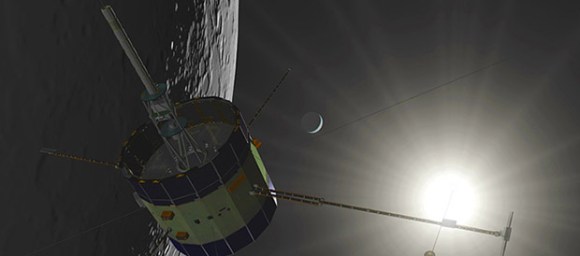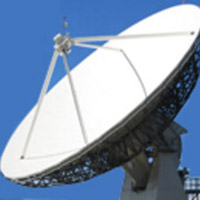
The team working to reboot the ISEE-3 satellite hurtling towards an August encounter with Earth is hard at work. They’ve put up a crowdfunding page, and now that they’re completely funded (don’t stop donating, btw), they’re starting to go deeper into the waters that will allow them to capture a forgotten satellite.
The project put up a status report going over what they’ve accomplished so far, and what work has yet to be done. For a few months now, they knew both transmitters aboard the craft were operational, but they were not sending telemetry. The team has gone through the documentation, came up with a set of commands, and are currently en route to Arecibo to transmit those commands.
Two ground station transmitters are being constructed, one specifically built to be installed at Arecibo for this application. The other is a portable, self-contained 700 watt transmitter that will be used at the official ISEE-3 ground station in Morehead State University in Kentucky.
With transmitters taken care of and receiving handled by an SDR from Ettus Research, a lot of work has focused on the command and telemetry systems. In 1978, the user interface for commands and telemetry was primitive to say the least. The team is now working on a system built-in Labview that’s much easier on the eyes than the vintage text terminal screens.
So far, signals from ISEE-3 are planned to be received at Arecibo, Morehead State, and Bochum observatory in Germany. This will give the team extremely good coverage for most of a day, and there are other ground stations in California that will extend the time the team is able to communicate with ISSE-3 each day by a few hours.
There’s still a lot of work to be done; the team really doesn’t know what systems are still operating, although most of them did make it 20 years with only one fault. In the next few days, we’ll all get to see if this satellite will be up to the task of coming back home to Earth. If everything goes to plan, ISEE-3 will be on track towards a 17 hour burn to put it on the correct trajectory some time in mid June.
















“The team is now working on a system built-in Labview that’s much easier on the eyes than the vintage text terminal screens.”
Minor issue: “built-in” should be “built in”
Major issue: Nothing is easier on the yes than text terminal screens! vintage or not. :)
“on the eyes” (karmic punishment for being a spelling-nazi i guess :)
“:))” you forgot the closing parenthesis in your karmic punishment.
http://xkcd.com/541/
I’ll just leave this here…
Muphry’s Law:
http://en.wikipedia.org/wiki/Muphry%27s_law
;)
Scott Manley did an interview with one of the team members involved with the ISEE-3 rescue mission. These are the same people who recovered all the lunar orbiter images off of their 60 year old tapes:
https://www.youtube.com/watch?v=m4D6pRT04PY
I was into this long before watching this video but Scott’s enthusiasm is really infectious. I really hope everything works out. Never thought I’d live to see the day when amateurs would be building their own space programs (Copenhagen Suborbitals) and commandeering old spacecraft. We’re living in the future!
Wonder if they will find evidence of Z>110 elements in the comet’s tail?
That X-ray spectrographic sensor might be able to detect them, if entropy hasn’t degraded it too much?
What you have just said is one of the most insanely idiotic things I have ever heard. At no point in your rambling, incoherent response were you even close to anything that could be considered a rational thought. Everyone in this room is now dumber for having listened to it. I award you no points, and may God have mercy on your soul.
http://xkcd.com/451/
@billy billy billy: Your comment is defamatory, insulting and totally unhelpful. It also makes you a troll. If you don’t have something nice to say, say nothing at all.
You are of course allowed to disagree with anyone, however for the benefit of all of us please try to explain your disagreement in a constructive way – maybe BotherSaidPooh knows something you don’t? Or maybe you just misunderstood.
http://www.youtube.com/watch?v=5hfYJsQAhl0
Troll pasting movie quotes.
LabView is an abomination :P … but hope things work out for them!
Yep, it’s by far the worst program for this kind of stuff. Except for all the others.
So glad to hear they got funded… this is huge!
It is but it makes me feel so small and inadequate.
Hey guys thanks for keeping an eye on us! Now that we’ve passed our initial goal of $125,000, we have asked for an extension to our crowd funding effort – a “stretch goal” of $150,000. As we developed the software, hardware, and procedures needed to contact and command the ISEE-3 spacecraft, it became clear to us that getting additional information on the precise location of the spacecraft was of great value. The best way to do that is to use NASA’s DSN (Deep Space Network). Since NASA is not funding our project, we’d need to pay them for this activity. Based on the time we’d need to use the DSN, $25,000 is a very good estimate. So, if you have not yet donated, here’s your chance. Meanwhile, First Contact will occur very soon – within the next week. Please consider helping this project at http://rkthb.co/42228 – Keith and Dennis
Hopefully the fuel hasn’t leaked out while the satellite has been idle.
I’d be more worried about the rocket engines exploding/breaking up as soon as they’re fired. (or soon after, a 17 hour burn is a long time)
yeah… if the last guy out forgot to tighten the gas cap, this whole thing is going to be an exercise in futility…
Is there going to be anything interesting happening at MSU that locals can come watch?
I see now why they need the additional 25grand or more — prob had to pay the 125g’s to a lawyer to be able to work nasa to let them have the spacecraft or at least use it — what happens after they figure it out will nasa take it back — no harm to the folks figuring this out — i dunno about this — good luck with your adventures — what is the frequency will they be using to talk to this bird
I was pretty sure NASA already gave their blessing (but not help, though). They were just gonna let the thing orbit forever, or until its orbit decayed and it fell into the sun or crashed into a planet, so it’s no loss to them to let someone else have it if they can get it to work.
Is your period key broken? What’s with using hyphens as your sole form of punctuation?
We did not have to pay any lawyers – anything.
Sure, aim it at the Earth. What could go wrong?
Um, since when has theorising that superheavy elements might have survived in a comet’s core been insane? I mean science only recently discovered that gold and other heavy elements are produced by colliding neutron stars.
I actually have possible proof that Z>110 is possible, see published work by Dr. Stefan Marinov. Also relevant, evidence of long term decay in ancient rocks of elements heavier than thorium which suggests that the “island of stability” could indeed be around Z=118 to 126 with 122 essentially bang in the middle.
Also relevant, my published theory circa 2012 that superheavy elements with hyperdeformed nuclei could decouple energy by the Cooper pairing mechanism as the nuclei rotate and thus shed decay energy below the bulk superconducting temperature if other elements such as mercury or magnesium are present.
The Island of Stability is hypothetical. AFAIK, there’s not even a lot of strong theoretical evidence. Remember that ‘stability’ in this instance is a relative term. Here, for an element to be stable simply means that it does not decay immediately upon formation. Past 118, they can still have half-lives in the order of seconds or years. Most likely not millennia.
Besides, ISEE isn’t really equipped to hunt for superheavy elements. X-Ray spectroscopy wouldn’t really be of much help in that regard. Even if there were superheavy elements in comet tails, we would have detected them, we’ve been looking for heavy elements in comet trails for a long time.
And your comment about entropy just doesn’t make any sense. Entropy doesn’t “degrade” things. I think you misunderstand what entropy is.
Apologies, i meant “Dr Amnon Marinov”, someone please edit this thanks.
Also I have contacted some of the original group about this and they seem to think I might be on the right track..
“Entropy” as in sensors degrade with exposure to space borne radiation.
Geiger tubes slowly degrade, noise levels go up in circuits, parts outright fail.
Sorry if I wasn’t clear enough.
Also, IIRC lawrencium has an observed half life much longer with certain isotopes.
Any consideration that if contact and reactivation is successful, that it will be put back to its original mission/location?